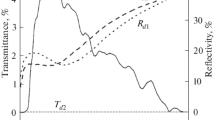Abstract
A theoretical analysis of and experimental observations on a parallel incident laser-induced deposition rate are reported. Our theory predicts that the maximum deposition rate depends on the photo-traveling length, the scattering cross section of the reactant gases and their partial pressure. This result is applied to SiO2 deposition using monosilane and nitrous oxide for reactant gases, and is compared with experimental results. We show that the deposition rate of SiO2 films as a function of the incident light power and the partial pressure of reactant gases predicted by the present theory well explains our experimental results. A supply-limitation phenomenon of the reactant gases and a method of estimating deposition efficiencies are also discussed.
Similar content being viewed by others
References
P.K. Boyer, G.A. Roche, W.H. Ritchie, G.J. Collins: Appl. Phys. Lett.40, 716 (1982)
T. Saitoh, S. Muramatsu, T. Shimada, M. Migitaka: Appl. Phys. Lett.42, 678 (1983)
R. Solanki, G.J. Coffins: Appl. Phys. Lett.42, 662 (1983)
J.Y. Tsao, R.A. Becher, D.J. Ehlich, F.J. Leonberger: Appl. Phys. Lett.42, 559 (1983)
S.D. Allen, A.B. Trinzubo: J. Appl. Phys.54, 1641 (1983)
T.H. Wood, J.C. White, B.A. Thacker: Appl. Phys. Lett.42, 408 (1983)
R.D. Hudson: J. Chem.52, 1465 (1974)
J.H. Clark, R.G. Anderson: Appl. Phys. Lett.32, 46 (1978)
This value is calculated from the absorption coefficient, 4.78×10−4 cm−1 at 273 K and 1 atm. This coefficient is cited fromThe Table of Physical Constants, ed. by S. Iida (Asakura, Tokyo 1969) p. 109
G.G.A. Perkins, E.R. Austin, F.W. Lampe: J. Am. Chem. Soc.101, 1109 (1979)
N.R. Greiner: J. Chem. Phys.47, 4373 (1967)
H. Niki, G.J. Mains: J. Chem. Phys.68, 304 (1964)
H.M. Kim, S.S. Tai, S.L. Groves, K.L. Schugraf: In Proc. 8th Conf. on Chemical Vapor Deposition, Electrochemical Society Proc.81–7, 258 (1981)
The chemical behavior of oxygen atoms and nitrous oxide molecules were overviewed by R.J. Cvetanović et al.: Can. J. Chem.52, 1452 (1974) and other pages of the same volume
Author information
Authors and Affiliations
Rights and permissions
About this article
Cite this article
Tate, A., Jinguji, K., Yamada, T. et al. Theoretical and experimental investigations on the deposition rate and processes of parallel incident laser-induced CVD. Appl. Phys. A 38, 221–226 (1985). https://doi.org/10.1007/BF00616500
Received:
Accepted:
Issue Date:
DOI: https://doi.org/10.1007/BF00616500




